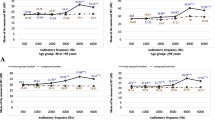Abstract
This study set out to determine the pattern and predictors of noise-induced hearing loss (NIHL) among small-scale and self-employed chili pepper grinders in Lagos, Southwest Nigeria. Audiological evaluation was conducted for all participants after noise level measurement. Of 136 studied, 85 (62.5%) were confirmed with slight-to-moderate NIHL. Mean age was 40.2 years, mean years spent as grinders was 9.3 years and mean hours spent daily at work was 13.3 hours. The mean age of those with NIHL was significantly higher than those without. Spending over 10 years in commercial grinding and working ≤12 hours daily were predictive of NIHL. Questionnaire-based screening using symptoms of NIHL was associated with a sensitivity of 44.7%, specificity of 62.7%, and positive predictive value of 66.7%. In conclusion, pepper grinding is associated with high/excessive noise levels and NIHL. Hearing conservation program incorporating engineering modification of locally fabricated grinders is warranted in this and similar populations in developing countries.


Similar content being viewed by others
References
United Nations Human Settlements Program (UN-Habitat). State of the World's Cities 2008/2009: Harmonious Cities. Nairobi, Kenya: UN-HABITAT; 2009.
Loayza NV. The Economics of the Informal Sector: a Simple Model and Some Empirical Evidence from Latin America. Washington DC: World Bank; 1997.
Henley A, Arabsheibani GR, Carneiro FG. On Defining and Measuring the Informal Sector. World Bank Policy Research Working Paper 3866. Washington DC: World Bank; 2006.
Chen MA. Women in the Informal Sector: a Global Picture, the Global Movement. Washington DC: World Bank; 2002.
Concha-Barrientos M, Campbell-Lendrum D, Steenland K. Occupational Noise: Assessing the Burden of Disease from Work-Related Hearing Impairment at National and Local Levels. Geneva, Switzerland: World Health Organization; 2004.
Zuskin E, Skuric Z, Kanceljak B, Pokrajac D, Schachter EN, Witek TJ. Respiratory findings in spice factory workers. Arch Environ Health. 1988; 43: 335–339.
Chan OY, Lee CS, Tan KT, Thirumoorthy T. Health problems among spice grinders. J Soc Occup Med. 1990; 40: 111–115.
Uragoda CG. Symptoms in spice workers. J Trop Med Hyg. 1992; 95: 136–139.
Lankatilake KN, Uragoda CG. Respiratory function in chilli grinders. Occup Med (Lond). 1993; 43: 139–142.
World Health Organization. Prevention of Hearing Impairment. Geneva, Switzerland: The World Health Assembly Resolution WHA 48.9; 1995.
International Organization for Standardization. Acoustics—Guidelines for the Measurement and Assessment of Exposure to Noise in a Working Environment. Geneva, Switzerland: International Organization for Standardization. ISO 9612 1997.
World Health Organization. Report of the Informal Working Group on Prevention of Deafness and Hearing Impairment. Program Planning. Geneva, Switzerland. WHO/PDH/91.1; 1991: 18–21.
Hinchcliffe R. Review: global perspective of noise-induced hearing loss as exemplified by Nigeria. J Audiol Med. 2002; 11: 1–24.
Rosenstock L, Cullen MR, Fingerhut M. Advancing worker health and safety in the developing world. J Occup Environ Med. 2005; 47: 132–136.
Fingerhut M, Driscoll T, Imel Nelson D, et al. Contribution of occupational risk factors to the global burden of disease. Scand. J Work Environ Health. 2005; (Suppl 1): 58–61.
Nelson DI, Nelson RY, Concha-Barrientos M, Fingerhut M. The global burden of occupational noise-induced hearing loss. Am J Ind Med. 2005; 48: 446–458.
ACOEM. Evidence-based statement: noise-induced hearing loss. J Occup Environ Med. 2003; 45: 579–581.
Omokhodion FO, Adeosun AA, Fajola AA. Hearing impairment among mill workers in small scale enterprises in southwest Nigeria. Noise Health. 2007; 9: 75–77.
American Academy of Pediatrics Committee on Environmental Health. Noise: a hazard for the fetus and newborn. Pediatrics. 1997;100: 724–727.
Ologe FE, Akande TM, Olajide TG. Occupational noise exposure and sensorineural hearing loss among workers of a steel rolling mill. Eur Arch Otorhinolaryngol. 2006; 263: 618–621.
Sindhusake D, Mitchell P, Smith W, et al. Validation of self-reported hearing loss. The Blue Mountains Hearing Study. Int J Epidemiol. 2001; 30: 1371–1378.
Ahmed HO, Dennis JH, Ballal SG. The accuracy of self-reported high noise exposure level and hearing loss in a working population in Eastern Saudi Arabia. Int J Hyg Environ Health. 2004; 207: 227–234.
Schow RL. Considerations in selecting and validating an adult/elderly hearing screening protocol. Ear Hear. 1991; 12: 337–448.
Funding sources
This project was supported by Hearing Conservation Council, UK for the acquisition of diagnostic audiological instrument. All related operational expenses were funded by Hearing International Nigeria [HING], a locally registered charity. None of the sponsors was involved in the study design, collection, analysis, and interpretation of data; the writing of the manuscript; or the decision to submit these results for publication.
Author information
Authors and Affiliations
Corresponding author
Rights and permissions
About this article
Cite this article
Olusanya, B.O., Bamigboye, B.A. & Somefun, A.O. Permanent Hearing Loss among Professional Spice Grinders in an Urban Community in Southwest Nigeria. J Urban Health 89, 185–195 (2012). https://doi.org/10.1007/s11524-011-9634-x
Published:
Issue Date:
DOI: https://doi.org/10.1007/s11524-011-9634-x




